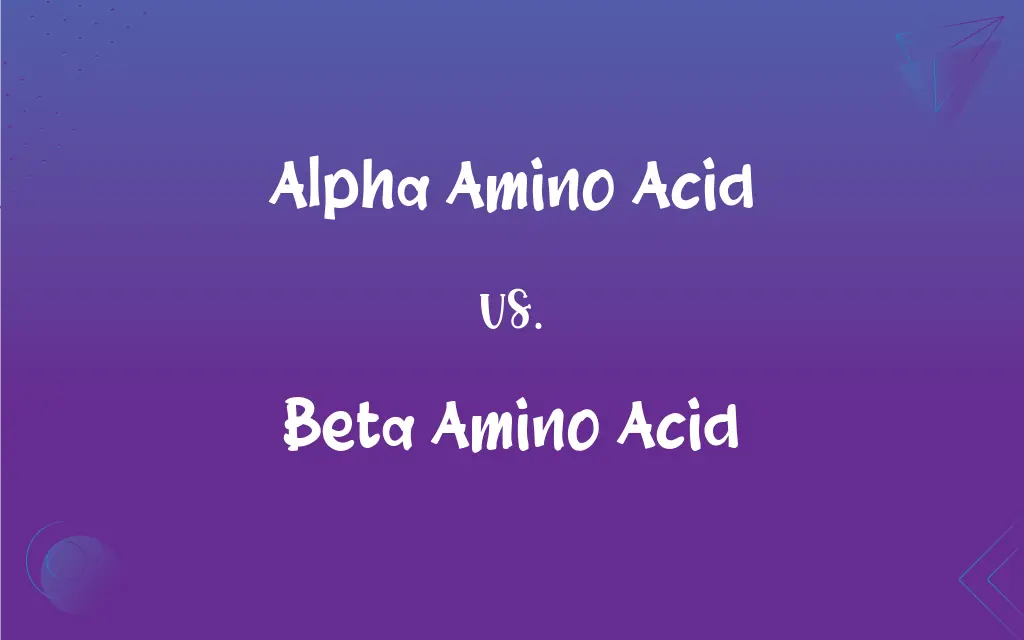Alpha Amino Acid vs. Beta Amino Acid: What's the Difference?
By Aimie Carlson & Janet White || Published on March 14, 2024
Alpha amino acids have the amino group attached to the alpha carbon atom next to the carboxyl group, while beta amino acids have the amino group attached to the beta carbon atom, one carbon away from the carboxyl group.

Key Differences
Alpha and beta amino acids are both fundamental components in the field of biochemistry and organic chemistry, differing primarily in the position of the amino group relative to the carboxyl group in their molecular structure. In alpha amino acids, the amino (-NH2) and carboxyl (-COOH) groups are attached to the same carbon atom, known as the alpha carbon. This configuration is prevalent in the amino acids that make up proteins, playing a crucial role in various biological processes, including the synthesis of enzymes, neurotransmitters, and hormones. Beta amino acids, on the other hand, feature the amino group attached to the beta carbon, which is one carbon atom removed from the alpha carbon and the carboxyl group. This slight structural difference leads to significant variations in their properties and roles in biological systems.
The structural arrangement of alpha amino acids facilitates their incorporation into peptides and proteins through peptide bonds, which are formed between the amino group of one amino acid and the carboxyl group of another. This process is fundamental to protein synthesis, determining the structure and function of proteins in organisms. Beta amino acids, due to their different structure, are less common in nature and not typically found in the proteins of most living organisms. However, they have been studied for their role in alternative peptide and protein structures, and their unique properties are of interest in the development of pharmaceuticals, biopolymers, and in the study of enzyme catalysis and metabolic pathways.
The presence of the amino group on the alpha carbon in alpha amino acids allows for the formation of stereoisomers, resulting in L- and D- configurations based on the orientation of the amino group in relation to the carboxyl group. This stereoisomerism is critical for the biological activity of amino acids and proteins. Beta amino acids also exhibit stereoisomerism, but their biological occurrence and significance are less well-understood compared to alpha amino acids.
In terms of biological function, alpha amino acids are essential for life, constituting the building blocks of proteins, which are involved in virtually every cellular process. Their specific sequences and arrangements within proteins determine the three-dimensional structures and functions of these vital biomolecules. Beta amino acids, while not common in natural proteins, have been explored for their potential in creating peptidomimetics—molecules that mimic the structure and function of peptides and proteins, offering potential applications in drug development and materials science.
The study and application of alpha amino acids are widespread in biochemistry, molecular biology, and medicine, given their central role in metabolism, genetic expression, and cellular structure. Beta amino acids, despite being less prevalent in natural biological systems, represent an area of growing interest in research due to their potential for creating novel polymers and therapeutic agents with unique properties not found in alpha amino acid-based molecules.
ADVERTISEMENT
Comparison Chart
Amino Group Position
Attached to the alpha carbon.
Attached to the beta carbon.
Commonality
Predominant in proteins and essential for life.
Less common in nature, not typically found in proteins.
Biological Role
Building blocks of proteins, enzymes, and neurotransmitters.
Studied for use in peptidomimetics and biopolymers.
Stereoisomerism
Exhibit L- and D- configurations, crucial for protein structure and function.
Also exhibit stereoisomerism, but with different implications.
Applications
Central in biochemistry, medicine, and molecular biology.
Interest in pharmaceuticals, materials science, and alternative biochemical pathways.
ADVERTISEMENT
Alpha Amino Acid and Beta Amino Acid Definitions
Alpha Amino Acid
Acts as enzymes or enzyme cofactors.
Serine is part of the active site in many enzymes.
Beta Amino Acid
Potential building blocks for biodegradable polymers.
Beta amino acid-based polymers for medical applications.
Alpha Amino Acid
Can form complex structures like alpha-helices and beta-sheets in proteins.
Alpha amino acids contribute to the diverse 3D structures of proteins.
Beta Amino Acid
Investigated for incorporation into non-natural proteins.
Designing beta amino acid-containing proteins with unique structural properties.
Alpha Amino Acid
Integral to forming peptide bonds and proteins.
Lysine is an essential alpha amino acid in many proteins.
Beta Amino Acid
Explored for their unique properties and applications.
Investigation into beta amino acids for novel biochemical functionalities.
Alpha Amino Acid
Encoded by DNA for protein synthesis.
The triplet codon AUG codes for the alpha amino acid methionine.
Beta Amino Acid
Used in designing molecules that mimic natural peptides.
Beta amino acids in drug development to create more stable compounds.
Alpha Amino Acid
Involved in energy production and biosynthesis.
Glutamate participates in nitrogen metabolism.
Beta Amino Acid
Can act as inhibitors or substrates in alternative metabolic pathways.
Beta amino acids studied for their role in specific enzymatic reactions.
FAQs
What research is being done on beta amino acids?
Research on beta amino acids focuses on their potential in creating new types of polymers, peptidomimetics, and exploring their biochemical and therapeutic applications.
Can beta amino acids be found in any proteins?
Beta amino acids are rare in natural proteins but have been explored in synthetic and engineered proteins for research and biotechnological applications.
What is the significance of stereoisomerism in amino acids?
Stereoisomerism affects the biological activity and protein integration of amino acids, with L-isomers being predominant in nature and essential for protein construction.
Can beta amino acids be synthesized in the laboratory?
Yes, beta amino acids can be synthesized through various organic chemistry techniques, allowing researchers to study their properties and potential applications in greater depth.
What are the environmental implications of synthesizing beta amino acids?
Synthesizing beta amino acids, like any chemical synthesis, can have environmental impacts depending on the processes and solvents used, highlighting the importance of green chemistry principles.
What makes alpha amino acids essential for life?
Alpha amino acids are essential due to their role as the building blocks of proteins, which are crucial for structure, function, and regulation in all living organisms.
How do the physical properties of alpha and beta amino acids differ?
The physical properties can vary due to the difference in molecular structure, affecting aspects like solubility, boiling point, and reactivity, with the position of the amino group in beta amino acids potentially leading to different chemical behaviors.
What role do alpha amino acids play in neurotransmission?
Certain alpha amino acids, such as glutamate and glycine, serve as neurotransmitters, facilitating communication between neurons in the brain and nervous system.
What is the significance of the alpha carbon in amino acids?
The alpha carbon is central in amino acids as it connects the amino group, carboxyl group, and side chain, determining the amino acid's properties and reactivity.
How are alpha and beta amino acids utilized in pharmaceuticals?
Alpha amino acids are used in drug formulations and therapies, while beta amino acids are being researched for creating more stable and selective drug molecules.
Why are beta amino acids less common in nature than alpha amino acids?
Beta amino acids are less common due to their deviation from the central biochemical pathways that utilize alpha amino acids for protein synthesis and metabolism, which are deeply conserved in biological systems.
How do alpha amino acids contribute to the immune system?
Alpha amino acids are crucial for the production of antibodies and immune system cells, playing a vital role in defending the body against pathogens.
What potential do beta amino acids have in nanotechnology?
Beta amino acids hold potential in nanotechnology for constructing nanoscale devices and materials, leveraging their unique structural properties for novel applications.
Are there any diseases associated with defects in amino acid metabolism?
Yes, there are several metabolic disorders related to amino acids, such as phenylketonuria (PKU), which involves a defect in the metabolism of the alpha amino acid phenylalanine.
Can beta amino acids form peptides and proteins like alpha amino acids?
While not common in natural proteins, beta amino acids can form peptides through synthetic methods, offering the potential for designing novel structures with unique properties.
What challenges exist in incorporating beta amino acids into biological systems?
Incorporating beta amino acids into biological systems poses challenges due to their unfamiliarity to most biological enzymes and pathways, requiring engineered systems for their integration and utilization.
How do alpha and beta amino acids interact with enzymes?
Alpha amino acids are recognized by a wide range of enzymes for metabolism and synthesis, while beta amino acids may not fit as well into enzyme active sites, limiting their natural biological reactions.
How are researchers exploring the evolutionary significance of alpha amino acid predominance?
Researchers explore the evolutionary significance by studying the biochemical pathways and molecular structures that have led to the predominance of alpha amino acids in proteins, suggesting a combination of chemical stability, functional versatility, and historical contingency in early life forms.
How might future research on beta amino acids impact biotechnology?
Future research could lead to new biotechnological applications, such as creating enzymes with novel catalytic activities or materials with unique mechanical and biochemical properties.
Are there dietary supplements that include beta amino acids?
While less common than alpha amino acid supplements, certain beta amino acids might be included in supplements for specific health or performance benefits, subject to ongoing research.
About Author
Written by
Aimie CarlsonAimie Carlson, holding a master's degree in English literature, is a fervent English language enthusiast. She lends her writing talents to Difference Wiki, a prominent website that specializes in comparisons, offering readers insightful analyses that both captivate and inform.
Co-written by
Janet WhiteJanet White has been an esteemed writer and blogger for Difference Wiki. Holding a Master's degree in Science and Medical Journalism from the prestigious Boston University, she has consistently demonstrated her expertise and passion for her field. When she's not immersed in her work, Janet relishes her time exercising, delving into a good book, and cherishing moments with friends and family.
































































